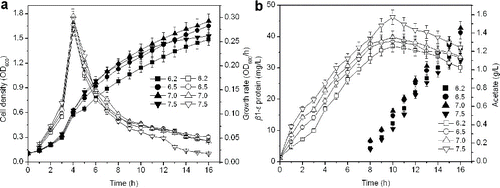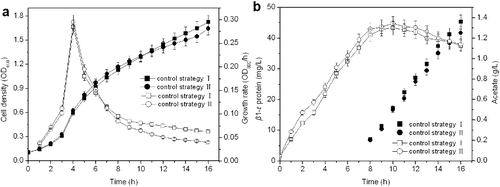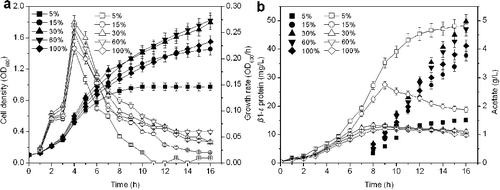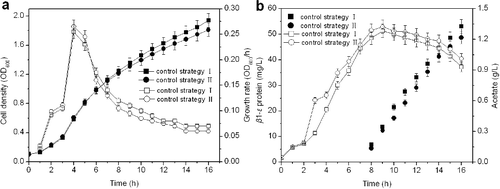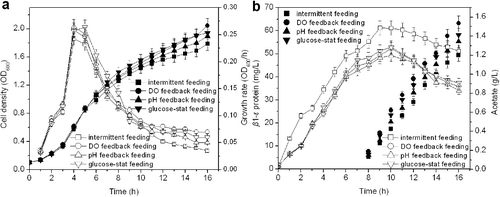ABSTRACT
The detoxified beta1–epsilon (β1–ϵ) toxin protein of Clostridium perfringens type B provides protection from C. perfringens types B, C and D infections. Acetate is the primary by-product from the cell growth and expression of β1–ϵ protein. In the present study, the effects of pH and dissolved oxygen (DO) on the expression of β1--ϵ protein were investigated. Two-stage pH and DO control strategies were developed for the expression of β1–ϵ protein. The obtained results indicated that higher cell density and concentration of β1--ϵ protein, and lower accumulation of acetate were obtained when pH was maintained at a constant level of 6.5 (0–6 h) and 7.0 (6–16 h), and the DO level was maintained at 60% (0–6 h) and 30% (6–16 h). Furthermore, the impact of intermittent, DO feedback, pH feedback and glucose-stat feeding on the expression of β1–ϵ protein were studied. By using the DO feedback feeding, combined with the stage control of pH (6.5 for 0–6 h, 7.0 for 6–16 h) and DO (60% for 0–6 h, 30% for 6–16 h), the highest cell density of 2.045 (absorbance at 600 nm) and a β1–ϵ protein concentration of 63.24 mg/L were obtained, and the accumulation of acetate decreased to 0.872 g/L.
Introduction
Clostridium perfringens is a gram-positive, spore-forming anaerobic bacterium that is widespread in the environment and in the animals' intestines, where it can be pathogenic under certain conditions.[Citation1] C. perfringens may cause numerous gastrointestinal infections in most mammalian species.[Citation2,Citation3] Based on the productivity of the main toxins (alpha-, beta-, epsilon- and iota-toxins), C. perfringens is classified into five types (A–E).[Citation4] These toxins have specific activities and roles in the disease process, and a synergistic action of the toxins on the host tissue is needed for the development of unique infectious lesions.[Citation5] Type B causes an often fatal haemorrhagic dysentery in sheep and other species, which is often accompanied by a sudden death or acute neurological signs.[Citation6] Beta (β) toxin, which is produced by C. perfringens type B and is an important virulence factor of this bacteria, may cause fatal diseases, originating in the intestines of people or livestock.[Citation7] Epsilon (ϵ) toxin is active in a wide range of animal species and plays a central role in enterotoxaemia of sheep and lambs.[Citation8,Citation9] Vaccination seems to be the most effective way to control intestinal clostridiosis, but the industrial production of Clostridium sp. toxins is laborious and poorly predictable.[Citation10] We have previously constructed a recombinant Escherichia coli, designated as B1-EP that expresses C. perfringens type B β1–ϵ toxin.[Citation11] It was constructed by transformation of the plasmid pET-32a with the genes encoding C. perfringens type B β1–ϵ protein. The immunization of mice with the detoxified protein β1–ϵ protected against a subsequent infection with β1 and ϵ toxins of C. perfringens types B, C and D.[Citation11] However, the expression level of β1–ϵ protein was low because of the accumulation of acetate. Thus, in order to improve the expression level of β1–ϵ protein in E. coli, it is important to decrease the excretion of acetate.
Acetate is a primary by-product in E. coli cultures, and its metabolism plays an important role in the control of the central metabolism and bioprocess performance.[Citation12] The excretion of acetate results in deficient utilization of carbon sources and inhibition of cellular growth and protein production.[Citation13] Many studies have reported a high-yield production of recombinant proteins obtained by reduction of the acetate accumulation.[Citation12] The pathways of phosphotransacetylase–acetate kinase (Pta–AckA) and pyruvate oxidase (PoxB) contribute to the synthesis of acetate.[Citation14] The acetate formation rate is directly related to the cell growth rate and the consumption rate of glucose, as the usual substrate. In the common operational mode of a fed-batch process, the growth rate of cells is determined by the glucose feeding rate.[Citation15] By using an appropriate glucose feeding strategy, the cell growth rate and glucose concentration were controlled at the low levels, which led to decreased acetate accumulation.[Citation13] It has been reported that most processes' design or genetic modifications to overcome acetate formation, ultimately aim to bring growth rate and oxygen consumption into a better balance.[Citation15]
E. coli grows over a wide pH range (4.4–9.2), and its own metabolism shifts the external pH towards either extreme, depending on the available nutrients and electron acceptors. pH also influences the culture conditions, including oxygenation, growth phase and metabolite composition.[Citation16] Cell growth rate is also affected by pH, and low cell growth rate occurs at low pH.[Citation17] Several enzymes related to the formation of acetate are induced at the pH extremes, including the proteins encoded by pta, sucB and sucC.[Citation16] Components of the tricarboxylic acid (TCA) cycle, such as sucB and sucC, are induced at low pH, which would be expected to result in utilization of the high proton potential and in increase of the TCA cycle capacity.[Citation16,Citation18] The key gene pta, which regulates pH, is involved in the synthesis of acetate and is induced at high pH that would be changed by the concentration of acetate.[Citation15,Citation16] During the L-tryptophan production, with low pH, maintained during the early fermentation period, the accumulation of acetate was decreased and higher production of L-tryptophan was obtained.[Citation17] A conducted study showed that the pH manipulation had an impact on the formation of inclusion bodies (IBs) and their physico-chemical characteristics, and, furthermore, uncontrolled pH conditions favoured the protein aggregation and sphingomyelinase D IB formation.[Citation19]
Dissolved oxygen (DO) levels affect the number of enzymes in the Embden–Meyerhof–Parnas (EMP), pentose phosphate (PP) and TCA cycle pathways, together with cytochrome measurements and transcription levels of key genes, related to the formation of acetate.[Citation18,Citation20] The enhanced acetate accumulation at lower DO is not only the result of lower TCA cycle activity, but also the result of altered transcription levels of genes associated with glucose and acetate metabolism. Whereas, at higher DO levels, the transcription levels of the gluconeogenesis genes (pckA, ppsA) and the anaplerotic pathway genes (ppc, sfcA) are higher, leading to decreased concentration of pyruvate and acetyl–CoA and causing reduction of acetate accumulation.[Citation18] However, the increased concentration of DO during the E. coli growth stimulates an increase in the intracellular concentration of reactive oxygen species (ROS), with high levels of ROS causing irreversible damage to the cellular components of E. coli.[Citation21]
The excretion of acetate is a result of lack of balance which is between the fast carbon influx into the central metabolism and the limited capacity of TCA cycle or respiration.[Citation13,Citation15] The accumulation of acetate is decreased by maintaining the concentration of glucose below a certain critical value.[Citation13,Citation15] The accumulation of acetate is avoided by using a combined strategy of exponential feeding and pH-stat feeding for the production of tumour necrosis factor-related apoptosis-inducing ligand (TRAIL) by E. coli. As a result, high concentrations of biomass and active soluble TRAIL were obtained.[Citation22] In the production of iturin A by Bacillus subtilis, a two-stage glucose-feeding strategy by a stepwise decrease in the feeding rate was proposed to adaptively respond to a variation in the glucose consumption rate throughout the feeding phase.[Citation23] A twofold higher concentration of iturin A was obtained when compared to that of a batch culture.[Citation23]
In the present study, the effects of different DO and pH levels on the expression of β1–ϵ protein by E. coli were investigated. Stage control strategies of DO and pH were developed for the expression of β1–ϵ protein. Furthermore, different feeding strategies were used for studying the effect of feeding methods on the expression of β1–ϵ protein.
Materials and methods
Bacteria and culture media
The E. coli B1-EP strain used for the expression of β1–ϵ protein of C. perfringens type B in this study was obtained from the earlier work in our laboratory,[Citation11] and stored at the Culture Collection of Shandong Binzhou Animal Science and Veterinary Medicine Academy. The strain was maintained on Luria--Bertani (LB) agar containing 100 mg/L ampicillin.
The seed medium contained the following ingredients: 1 g/L glucose, 10 g/L tryptone, 5 g/L yeast extract and 10 g/L NaCl. The medium for expression of β1--ϵ protein contained the following ingredients: 2 g/L glucose, 1 g/L yeast extract, 2 g/L (NH4)2SO4, 1.5 g/L sodium citrate and 2 g/L KH2PO4. The pH of both seed and expression medium was adjusted to 7.0 with 4 mol/L NaOH. The ingredients of the seed and expression medium were obtained from Oxoid Ltd. (Hants, England).
Culture methods
A single colony of E. coli B1-EP was inoculated into a 250-mL baffled flask containing 50 mL seed medium. The colony was then cultivated at 30 ℃ with shaking at 200 rpm for 12 h. The culture grown in the baffled flask (2%, v/v) was inoculated aseptically into the 10-L fermenter (GRJ-10D Bioprocess Controller, Gerui, Zhenjiang, China) containing 5 L expression medium. The temperature was maintained at 30 ℃ during the cell growth period and at 25 ℃ during the expression phase of β1–ϵ protein. Unless otherwise specified, pH and DO were maintained at 7.0 and 30%, respectively, and the glucose concentration was maintained at 0.5 g/L by adding a glucose solution (50%, w/v) to the fermenter when the initial glucose was depleted. When the cell density increased (the absorbance was measured at 600 nm using a spectrophotometer 722N, INESA, Shanghai, China) and reached value between 0.7 and 0.8, isopropyl thiogalactose (IPTG; Merck, Kenilworth, NJ, USA) was added into the fermenter. The concentration of IPTG was maintained at 0.5 mmol/L, in order to induce an expression of β1–ϵ protein. The total cultivation time in the fermenter was 16 h.
Control strategy of pH, DO and glucose feeding
The pH was maintained at 6.2, 6.5, 7.0 and 7.5 and the expression of β1–ϵ protein (mg/L), cell density, growth rate of the cells (OD600/h) and acetate concentration (g/L) were measured. Based on the obtained results with different pH, two-stage pH control strategies (I: 6.5 (0–6 h), 7.0 (6–16 h), and II: 7.0 (0–6 h), 6.5 (6–16 h)) were developed for the expression of β1–ϵ protein. The DO levels were maintained at 5%, 15%, 30%, 60% and 100%, and the same characteristics of the process, as the above, were measured. According to the obtained results with different DO levels, two-stage DO control strategies (I: 60% (0–6 h), 30% (6–16 h), and II: 30% (0–6 h), 60% (6–16 h)) were proposed for the expression of β1–ϵ protein. The intermittent, DO feedback, pH feedback and glucose-stat feedings were also used for the expression of β1–ϵ protein.
Analysis of fermentation products
The DO, pH and temperature were measured automatically with electrodes attached to the fermenters. The optical density (OD) of the strain was monitored by measuring the absorbance at 600 nm using a spectrophotometer (722N, INESA, Shanghai, China).[Citation24] The growth rate of the cells (OD600/h) was calculated according to the cell density. The concentration of glucose was monitored by SBA-40E biosensor analyzer (Biology Institute of Shandong Academy of Sciences, Jinan, China). The concentration of acetate (g/L) was determined by high-pressure liquid chromatography system using an Agilent 1206 system (Agilent Technologies, CA, USA) equipped with an Aminex HPX-87H column (Bio-Rad, CA, USA) and a refractive index detector (Agilent Technologies, CA, USA).
Concentration of β1–ϵ protein
The protein of β1--ϵ was extracted and purified by using AKTA purifier (GE Healthcare, USA), and the concentration of β1–ϵ protein (mg/L) was determined by using the protein quantification kit of bicinchoninic acid (BCA) method (BioTeKe, Beijing, China).
Statistical analyses
The statistical analyses were conducted according to a previously reported method.[Citation25] A p < 0.05 was considered to indicate statistical significance.
Results and discussion
Effect of pH control strategy on the expression of β1–ϵ protein by E. coli
Different pH values
The expression of β1–ϵ protein by E. coli at different pH values (6.2, 6.5, 7.0 and 7.5) is displayed in . With pH maintained at 7.0, the cell density and concentration of β1–ϵ protein had the highest values of 1.712 and 42.75 mg/L, respectively, and the accumulation of acetate was also higher (1.143 g/L). During the early fermentation period, the cell growth rate increased with the increase of the pH. The activity of enzymes related to cell growth was lower at low pH, which resulted in reduced growth rate of the strain.[Citation17] The excretion of acetate increased with increasing of the pH value. The lowest concentration of acetate after 16 h of cultivation (1.024 g/L) was accumulated at pH 6.2, whereas the highest accumulation of acetate after 16 h of cultivation (1.243 g/L) was accumulated at pH 7.5. It has been proven that overloading the TCA cycle by rapid metabolic flux through glycolysis is considered to be the primary cause of acetate accumulation.[Citation18] The capacity of TCA cycle was increased at lower pH, because of the higher transcription levels of sucB and sucC genes, leading to decreased accumulation of pyruvate and acetate.[Citation16] The gene pta, induced at higher pH values, caused the improvement of acetate accumulation.[Citation16] Due to the highest accumulation of acetate at pH 7.5, the cell density (1.514) and concentration of β1–ϵ protein (32.35 mg/L) were the lowest at the same pH value.[Citation20]
Different pH control strategies
Based on the results obtained with different pH values, two-stage pH control strategies were applied for the assessment of the β1–ϵ protein expression, that is, pH stage control I: 6.5 (0–6 h), 7.0 (6–16 h) and II: 7.0 (0–6 h), 6.5 (6–16 h). The expression of β1–ϵ protein with pH control strategies I and II are presented in . The highest values of cell density and concentration of β1–ϵ protein obtained with pH control strategy I were 1.725 and 45.32 mg/L, which were 1.05 and 1.09 times higher than the ones obtained with pH control strategy II, respectively. The accumulation of acetate with pH control strategies I and II after 16 h of cultivation was 1.125 g and 1.140 g/L, respectively. Because lower pH was maintained during the initial fermentation phase with pH control strategy I, lower growth rate of the strain was obtained. The accumulation of acetate may also be caused by a cell growth rate above a certain threshold value for acetate formation.[Citation26] In a previous study, during the production of L-tryptophan, the cell growth rate was controlled at an appropriate value by using the pH stage control strategy, which resulted in decreased excretion of acetate and increased biomass and production of L-tryptophan.[Citation17] A pH maintained at 6.5 (0–6 h) and 7.0 (6–16 h) was beneficial for the expression of β1–ϵ protein.
Effect of DO control strategy on the expression of β1–ϵ protein by E. coli
Different DO levels
shows the expression of β1–ϵ protein at different DO levels (5%, 15%, 30%, 60% and 100%). The accumulation of acetate decreased when the DO level was higher. An acetate concentration of 4.827 g/L was accumulated at 5% DO level, whereas an acetate concentration of 0.975 g/L was obtained at 100% DO level. The lower TCA cycle activity at oxygen limitation and the altered transcription levels of genes associated with glucose and acetate metabolism caused the increase of the acetate accumulation at lower DO levels. A northern blot analysis conducted in a previous study indicated that only the Pta–AckA pathway genes were transcribed at higher oxygen concentration, and both genes of the Pta–AckA pathway, as well as the gene of PoxB, seem to be transcribed at low oxygen concentrations.[Citation18] In the present study, a cell density of 1.798 and the highest concentration of β1–ϵ protein (49.82 mg/L) were obtained at 30% DO, whereas the lowest cell density (0.978) and the lowest β1–ϵ protein concentration (15.12 mg/L) were obtained at 5% DO. When DO level was above 30%, the cell density and concentration of β1–ϵ protein decreased, which may be caused by the higher concentration of ROS at higher DO levels.[Citation21] The cell density and concentration of β1--ϵ protein obtained at DO of 60% were 1.827 and 47.87 mg/L, respectively. The highest cell density was obtained at 60% DO, and the highest concentration of β1–ϵ protein was obtained at 30% DO. Compared with the acetate excretion of 1.115 g/L at 30% DO, the acetate excretion at 60% DO was decreased with 9.15%.
Different DO control strategies
According to the β1–ϵ protein expression assay at different DO levels, DO control strategy I: 60% (0–6 h), 30% (6–16 h) and II: 30% (0–6 h), 60% (6h–16 h) were used for the expression of β1–ϵ protein. The expression of β1–ϵ protein with DO control strategies I and II are presented in . The cell density and concentration of β1–ϵ protein obtained with DO control strategy I after 16 h of cultivation were 1.943 and 53.12 mg/L, which were 7.23% and 9.03% higher than these with control strategy II, respectively. The E. coli culture maintained at high DO level decreased the metabolic flux of the EMP pathway and the TCA cycle and increased the metabolic flux of the PP pathway, leading to lower accumulation of acetate.[Citation27] The concentration of acetate accumulated at DO control strategy I after 16 h of cultivation was 0.932 g/L and it was 1.011 g/L at DO control strategy II. The strain growth rate with DO control strategy I during the initial fermentation period was lower than that with DO stage control II because of the high DO level.[Citation21]
Effect of different feeding strategies on the expression of β1-ϵ protein by E. coli
shows the expression of β1–ϵ protein with different feeding strategies, including intermittent, DO feedback, pH feedback and glucose-stat feeding. The lowest cell density (1.787) and concentration of β1--ϵ protein (49.27 mg/L), and the highest accumulation of acetate (1.243 g/L) were obtained after 16 h of cultivation with intermittent feeding. Process parameters, such as pH and DO, can reflect the condition of the carbon source in the fermentation processes. Changes in DO and pH can be monitored easily to reduce the formation of acetate during the fed-batch fermentation.[Citation22] The DO feedback feeding can be used to avoid substrate overfeeding and oxygen limitation.[Citation13] The highest cell density (2.045) and concentration of β1–ϵ protein (63.24 mg/L), and 0.872 g/L accumulation of acetate were obtained after 16 h of cultivation by using the DO feedback feeding. In a previous study, when the balanced DO-stat feeding strategy was used for the production of phenylalanine, the concentration of acetate was kept at zero during the entire cultivation period, and both cell density and production of phenylalanine were increased markedly.[Citation28] The lowest concentration of acetate (0.831 g/L) was obtained with pH feedback feeding, and the cell density and concentration of β1–ϵ protein after 16 h of cultivation were 1.857 and 55.41 mg/L, respectively. In another study, during a butanol production by Clostridium saccharoperbutylacetonicum, the pH-controlled fed-batch culture resulted in acceleration of lactate consumption and a further increase in the production of butanol.[Citation29] In the production of recombinant lipoprotein antigen, the concentration of acetate during a glucose-stat feeding was sufficiently low and no adverse growth effects were observed.[Citation13] By using the glucose-stat feeding during the expression of β1–ϵ protein in the present study, 0.912 g/L acetate was accumulated and the cell density and concentration of β1–ϵ protein at the end of the fermentation process were 1.953 and 59.21 mg/L, respectively. Thus, the DO feedback feeding was the most appropriate feeding strategy for the expression of β1–ϵ protein.
Conclusions
In the present study, the accumulation of acetate was obviously decreased by the application of pH and DO control strategies, and DO feedback feeding, which led to increased cell density and β1--ϵ protein concentration. The pH control at 6.5 (0–6 h) and 7.0 (6–16 h) and DO level, maintained at 60% (0–6 h) and 30% (6–16 h), had a positive impact on the reduction of acetate accumulation and improvement of cell growth and β1–ϵ protein concentration. With the use of the above pH and DO control strategies, and DO feedback feeding, the highest cell density and concentration of β1–ϵ protein were obtained and the lowest concentration of acetate was accumulated. The enhancement of the expression level of β1–ϵ protein can decrease the production cost and expand the application market for the vaccine of β1–ϵ toxin protein. This may lead to the prevention of diseases occurrence, caused by C. perfringens types B, C and D, and promotion of the sheep industry development.
Disclosure statement
No potential conflict of interest was reported by the authors. Chuwen Lin and Likun Cheng contributed equally to this work.
Additional information
Funding
References
- Urbina P, Flores-Díaz M, Alape-Girón A, et al. Phospholipase C and sphingomyelinase activities of the Clostridium perfringens α-toxin. Chem Phys Lipids. 2009;159:51–57.
- Uzal FA, Vidal JE, McClane BA, et al. Clostridium perfringens toxins involved in mammalian veterinary diseases. Open Toxinol J. 2010;3:24–42.
- Uzal FA, McClane BA. Recent progress in understanding the pathogenesis of Clostridium perfringens type C infections. Vet Microbiol. 2011;153(1–2):37–43.
- Ohtani K, Shimizu T. Regulation of toxin gene expression in Clostridium perfringens. Res Microbiol. 2015;166(4):280–289.
- Rood JI. Virulence genes of Clostridium perfringens. Annu Rev Microbiol. 1998;52:333–360.
- Uzal FA. Diagnosis of Clostridium perfringens intestinal infections in sheep and goats. Anaerobe. 2004;10:135–143.
- Milach A, de los Santos RJ, Turnes CG, et al. Production and characterization of Clostridium perfringens recombinant β toxoid. Anaerobe. 2012;18:363–365.
- Titball RW. Clostridium perfringens vaccines. Vaccine. 2009;27:D44–D47.
- Langroudi P, Pour RA, Shamsara K, et al. Fusion of Clostridium perfringens type D and B epsilon and beta toxin genes and it's cloning in E. coli. Arch Razi Inst. 2011;66(1):1–10.
- Nijland R, Lindner C, van Hartskamp M, et al. Heterologous production and secretion of Clostridium perfringens β-toxoid in closely related Gram-positive hosts. J Biotechnol. 2007;127:361–372.
- Lin CW, Zhang SL, Liu L, et al. Cloning and expression of β1 toxin of Clostridium perfringens type B C58-1 strain. China Anim Husb Vet Med. 2015;42(2):324–330.
- Castaño-Cerezo S, Pastor JM, Renilla S, et al. An insight into the role of phosphotransacetylase (pta) and the acetate/acetyl-CoA node in Escherichia coli. Microb Cell Fact. 2009;8:54. Available from: http://www.microbialcellfactories.com/content/8/1/54
- Cheng LK, Wang J, Xu QY, et al. Effect of feeding strategy on L-tryptophan production by recombinant Escherichia coli. Ann Microbiol. 2012;62:1625–1634.
- Nahku R, Valgepea K, Lahtvee PJ, et al. Specific growth rate dependent transcriptome profiling of Escherichia coli K12 MG1655 in accelerostat cultures. J Biotechnol. 2010;145(1):60–65.
- Eiteman MA, Altman E. Overcoming acetate in Escherichia coli recombinant protein fermentations. Trends Biotechnol. 2006;24(11):530–536.
- Stancik LM, Stancik DM, Schmidt B, et al. pH-dependent expression of periplasmic proteins and amino acid catabolism in Escherichia coli. J Bacteriol. 2004;184(15):4246–4258.
- Cheng LK, Wang J, Xu QY, et al. Strategy for pH control and pH feedback-controlled substrate feeding for high-level production of L-tryptophan by Escherichia coli. World J Microbiol Biotechnol. 2013;29:883–890.
- Phue JN, Shiloach J. Impact of dissolved oxygen concentration on acetate accumulation and physiology of E. coli BL21, evaluating transcription levels of key genes at different dissolved oxygen conditions. Metab Eng. 2005;7:353–363.
- Castellanos-Mendoza A, Castro-Acosta RM, Olvera A, et al. Influence of pH control in the formation of inclusion bodies during production of recombinant sphingomyelinase-D in Escherichia coli. Microb Cell Fact. 2014;13:137.
- Thomas AD, Doelle HW, Westwood AW, et al. Effect of oxygen on several enzymes involved in the aerobic and anaerobic utilization of glucose in Escherichia coli. J Bacterol. 1972;112(3):1099–1105.
- Baez A, Shiloach J. Escherichia coli avoids high dissolved oxygen stress by activation of SoxRS and manganese superoxide dismutase. Microb Cell Fact. 2013;12:23.
- Shen YL, Zhang Y, Sun AY, et al. High-level production of soluble tumor necrosis factor-related apoptosis-inducing ligand (Apo21/TRAIL) in high-density cultivation of recombinant Escherichia coli using a combined feeding strategy. Biotechnol Lett. 2004;26:981–984.
- Jin H, Li KP, Niu YX, et al. Continuous enhancement of iturin A production by Bacillus subtilis with a stepwise two-stage glucose feeding strategy. BMC Biotechnol. 2015;15:53.
- Cheng LK, Wang J, Fu Q, et al. Optimization of carbon and nitrogen sources and substrate feeding strategy to increase the cell density of Streptococcus suis. Biotechnol Biotechnol Equip. 2015;29(4):779–785.
- Wang J, Cheng LK, Chen N. High-level production of L-threonine by recombinant Escherichia coli with combined feeding strategies. Biotechnol Biotechnol Equip. 2014;28(3):495–501.
- Shin S, Chang DE, Pan JG. Acetate consumption activity directly determines to the level of acetate accumulation during Escherichia coli W3110 growth. J Microbiol Biotechnol. 2009;19(10):1127–1134.
- Huang J, Xu QY, Wen TY, et al. Metabolic flux analysis of L-threonine biosynthesis strain under diverse dissolved oxygen conditions. Acta Microbiol Sin. 2008;48(8):1056–1600.
- Konstantinov K, Kishimoto M, Seki T, et al. A balanced DO-stat and its application to the control of acetic acid excretion by recombinant E. coli. Biotechnol Bioeng. 1990;36(7):750–758.
- Oshiro M, Hanada K, Tashiro Y, et al. Efficient conversion of lactic acid to butanol with pH-stat continuous lactic acid and glucose feeding method by Clostridium saccharoperbutylacetonicum. Appl Microbiol Biotechnol. 2010;87(3):1177–1185.

